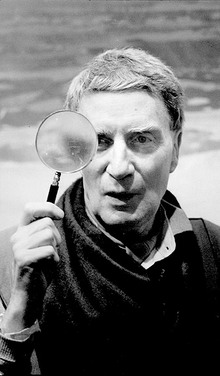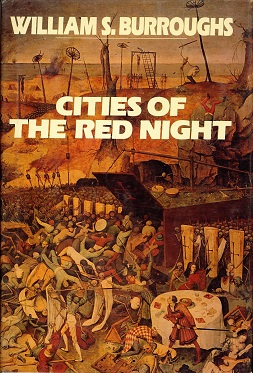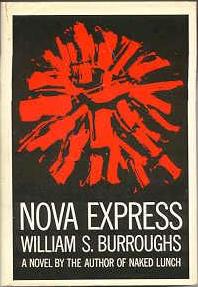
Brion Gysin was a British-Canadian painter, writer, sound poet, performance artist and inventor of experimental devices.

William Seward Burroughs II was an American writer and visual artist. He is widely considered a primary figure of the Beat Generation and a major postmodern author who influenced popular culture and literature. Burroughs wrote eighteen novels and novellas, six collections of short stories and four collections of essays, and five books have been published of his interviews and correspondences; he was initially briefly known by the pen name William Lee. He also collaborated on projects and recordings with numerous performers and musicians, made many appearances in films, and created and exhibited thousands of visual artworks, including his celebrated "Shotgun Art".

Naked Lunch is a 1959 novel by American writer William S. Burroughs. The book is structured as a series of loosely connected vignettes, intended by Burroughs to be read in any order. The novel follows the junkie William Lee, who takes on various aliases, from the U.S. to Mexico, eventually to Tangier and the dreamlike Interzone.

Naked Lunch is a 1991 surrealist science fiction drama film written and directed by David Cronenberg and starring Peter Weller, Judy Davis, Ian Holm, and Roy Scheider. It is an adaptation of William S. Burroughs' 1959 novel of the same name, and an international co-production of Canada, Britain, and Japan.

The Soft Machine is a 1961 novel by American author William S. Burroughs. It was originally composed using the cut-up technique partly from manuscripts belonging to The Word Hoard. It is the first part of The Nova Trilogy.
The 23 enigma is a belief in the significance of the number 23. The concept of the 23 enigma has been popularized by various books, movies, and conspiracy theories, which suggest that the number 23 appears with unusual frequency in various contexts and may be a symbol of some larger, hidden significance. A topic related to the 23 enigma is eikositriophobia, which is the fear of the number 23.

Cities of the Red Night is a 1981 novel by American author William S. Burroughs. His first full-length novel since The Wild Boys (1971), it is part of his final trilogy of novels, known as The Red Night Trilogy, followed by The Place of Dead Roads (1983) and The Western Lands (1987). The plot involves a group of radical pirates who seek the freedom to live under the articles set out by Captain James Misson. In near present day, a parallel story follows a detective searching for a lost boy, abducted for use in a sexual ritual. The cities of the title mimic and parody real places, and Burroughs makes references to the United States, Mexico, and Morocco.

Junkie: Confessions of an Unredeemed Drug Addict is a novel by American beat generation writer William S. Burroughs, initially published under the pseudonym William Lee in 1953. His first published work, it is semi-autobiographical and focuses on Burroughs' life as a drug user and dealer.

The Ticket That Exploded is a 1962 novel by American author William S. Burroughs, published by Olympia Press and later by Grove Press in 1967. Together with The Soft Machine and Nova Express it is part of a trilogy, referred to as The Nova Trilogy, created using the cut-up technique, although for this book Burroughs used a variant called 'the fold-in' method. The novel is an anarchic tale concerning mind control by psychic, electronic, sexual, pharmaceutical, subliminal, and other means. Passages from the other two books and even from this book show up in rearranged form and are often repeated. This work is significant for fans of Burroughs, in that it describes his idea of language as a virus and his philosophy of the cut-up technique. It also features the cut-up technique being used by characters within the story. The Ticket That Exploded lays the groundwork for Burroughs' ideas of social revolution through technology, which he would later detail in his book-length essay The Electronic Revolution.

Dead Fingers Talk, first published in 1963, was the fifth novel published by Beat Generation author William S. Burroughs. The book was originally published by John Calder in association with Olympia Press.

Apomorphine, sold under the brand name Apokyn among others, is a type of aporphine having activity as a non-selective dopamine agonist which activates both D2-like and, to a much lesser extent, D1-like receptors. It also acts as an antagonist of 5-HT2 and α-adrenergic receptors with high affinity. The compound is historically a morphine decomposition product made by boiling morphine with concentrated acid, hence the -morphine suffix. Contrary to its name, apomorphine does not actually contain morphine or its skeleton, nor does it bind to opioid receptors. The apo- prefix relates to it being a morphine derivative ("[comes] from morphine").
The Word Hoard was a large body of text produced by author William S. Burroughs between roughly 1954 and 1958.
The Nova Trilogy or The Cut-up Trilogy is a name commonly given by critics to a series of three experimental novels by William S. Burroughs.
A vignette is a French loanword expressing a short and descriptive piece of writing that captures a brief period in time. Vignettes are more focused on vivid imagery and meaning rather than plot. Vignettes can be stand-alone, but they are more commonly part of a larger narrative, such as vignettes found in novels or collections of short stories.

The Western Lands is a 1987 novel by William S. Burroughs. The final book of the trilogy that begins with Cities of the Red Night (1981) and continues with The Place of Dead Roads (1983), its title refers to the western bank of the Nile River, which in Egyptian mythology is the Land of the Dead. Inspired by the Egyptian Book of the Dead, Burroughs explores the after-death state by means of dream scenarios, hallucinatory passages, talismanic magic, occultism, superstition, and his characteristic view of the nature of reality.

Ali's Smile: Naked Scientology is a collection of essays and a short story by American Beat writer William S. Burroughs (1914–1997). First published in 1971 as the short story "Ali's Smile", the book eventually contained a group of previously published newspaper articles as well, all of which address Scientology. Burroughs had been interested in Scientology throughout the 1960s, believing that its methods might help combat a controlling society. He joined the Church of Scientology later in the decade. However, he became disenchanted with the authoritarian nature of the organization. In 1970 Burroughs had published a "considered statement" on Scientology's methods because he felt they were significant enough to warrant commentary. These pieces were later gathered together into Ali's Smile: Naked Scientology, which religious studies scholar Hugh B. Urban describes as a "nonscholarly popular exposé of Scientology". Burroughs's texts argue that while some of Scientology's therapies are worthwhile, the dogmatic nature of the group and its secrecy are harmful.

Bulbocapnine is an alkaloid found in Corydalis and Dicentra, genera of the plant family Fumariaceae which have caused the fatal poisoning of sheep and cattle. It has been shown to act as an acetylcholinesterase inhibitor, and inhibits biosynthesis of dopamine via inhibition of the enzyme tyrosine hydroxylase. Like apomorphine, it is reported to be an inhibitor of amyloid beta protein (Aβ) fiber formation, whose presence is a hallmark of Alzheimer's disease (AD). Bulbocapnine is thus a potential therapeutic under the amyloid hypothesis. According to the Dorlands Medical Dictionary, it "inhibits the reflex and motor activities of striated muscle. It has been used in the treatment of muscular tremors and vestibular nystagmus".
Oliver C. G. Harris is a British academic and Professor of American Literature at Keele University. He is the author and editor of seventeen books, including a dozen editions of works by William S. Burroughs: Letters, 1945–1959 (1993), Junky: the definitive text of Junk (2003), The Yage Letters Redux (2006), Queer (2010), The Cut-Up Trilogy, The Soft Machine, Nova Express, and The Ticket That Exploded (2014), Blade Runner: A Movie (2019), Minutes to Go Redux (2020), The Exterminator Redux (2020), BATTLE INSTRUCTIONS (2020) and Dead Fingers Talk (2020). In 2022, he published two short books of essays, A Burroughs Triptych and Making Naked Lunch and in 2023 a collaborative hybrid of criticism and memoir, Two Assassins: William Burroughs/Hassan Sabbah. He is President of the European Beat Studies Network.
This is a bibliography of the works of William S. Burroughs.

Call Me Burroughs is a spoken word album by Beat Generation author William S. Burroughs, which was released on LP by The English Bookshop, Paris, in June 1965, and then issued in the United States by ESP-Disk, New York, in 1966. Rhino Word Beat reissued the album on Compact Disc in 1995, the company's first ever reissue.














